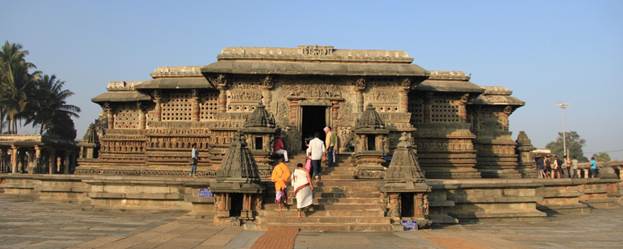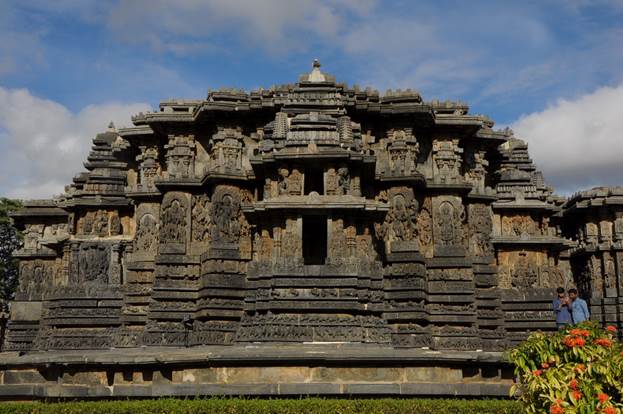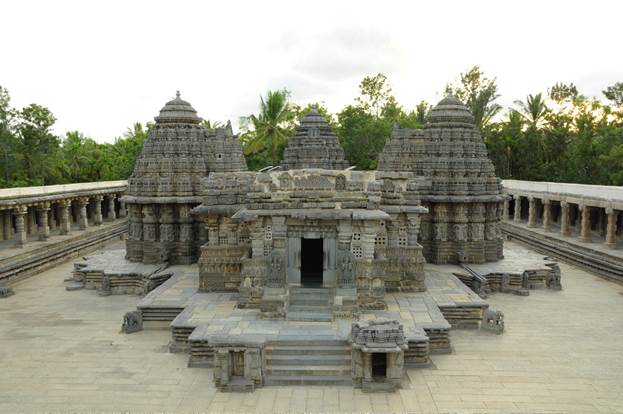World Heritage Nomination 2022-2023 | 02 Feb 2022
For Prelims: World Heritage site, Hoysala architecture, Nagara & Dravidian architecture.
For Mains: Indian Heritage & Culture.
Why in News?
Recently, the Union Ministry of Culture has nominated Sacred Ensembles of the Hoysalas temples for consideration as a World Heritage site for the year 2022-2023.
- The sacred ensembles of the Hoysalas, built in the 12th-13th centuries and represented by the three components of Belur, Halebid and Somnathapura in Karnataka. All these three Hoysala temples are protected monuments of the Archaeological Survey of India (ASI).
- The 'Sacred Ensembles of the Hoysala' have been on UNESCO's Tentative list since 15th April, 2014 and stand testimony to the rich historical and cultural heritage of India.
- Earlier, the UNESCO’s World Heritage Centre (WHC) had agreed to publish Hindi descriptions of India's UNESCO World Heritage Sites on the WHC website.
What are the Features of Belur, Halebid, and Somnathapura temples ?
- Chennakeshava Temple, Belur:
- Construction of the temple commenced in 1117 AD and took 103 years to complete.
- The temple is dedicated to Lord Vishnu known as Chennakesava, which means beautiful (chenna) Vishnu (Keshava).
- The richly sculptured exterior of the temple narrates scenes from the life of Vishnu and his reincarnations and the epics, Ramayana, and Mahabharata.
- However, some of the representations of Shiva are also included.
- Hoysaleshwara Temple, Halebidu:
- The Hoysaleshwara temple at Halebidu is the most exemplary architectural ensemble of the Hoysalas extant today.
- Built in 1121CE during the reign of the Hoysala King, Vishnuvardhana Hoysaleshwara.
- The temple, dedicated to Shiva, was sponsored and built by wealthy citizens and merchants of Dorasamudra.
- The temple is most well-known for the more than 240 wall sculptures that run all along the outer wall.
- Halebid has a walled complex containing three Jaina basadi (temples) of the Hoysala period as well as a stepped well.
- Keshava Temple, Somanathapura:
- The Keshava temple at Somanathapura is another magnificent Hoysala monument, perhaps the last.
- This is a breathtakingly beautiful Trikuta Temple dedicated to Lord Krishna in three forms – Janardhana, Keshava and Venugopala.
- Unfortunately, the main Keshava idol is missing, and the Janardhana and Venugopala idols are damaged.
What are the Characteristics of Hoysala Architecture?
- Hoysala architecture is the building style developed under the rule of the Hoysala Empire between the 11th and 14th centuries, mostly concentrated in southern Karnataka.
- Hoysala temples are sometimes called hybrid or vesara as their unique style seems neither completely Dravida nor Nagara, but somewhere in between.
- The Hoysala temples have a basic Darvidian morphology but show strong influences of the Bhumija mode widely used in Central India, the Nagara traditions of northern and western India, and the Karntata Dravida modes favoured by the Kalyani Chalukyas.
- Therefore, the Hoysala architects made considered and informed eclectic selections of features from other temple typologies which they further modified and then complemented with their own particular innovations.
- The result was the birth of a completely novel 'Hoysala Temple' form.
- The Hoysala temples, instead of consisting of a simple inner chamber with its pillared hall, contain multiple shrines grouped around a central pillared hall and laid out in the shape of an intricately-designed star (stellate-plan).
- Since they are made out of soapstone which is a relatively soft stone, the artists were able to carve their sculptures intricately. This can be seen particularly in the jewellery of the gods that adorn their temple walls.
What is a World Heritage Site?
- About:
- Any of various areas or objects inscribed on the United Nations Educational, Scientific and Cultural Organization (UNESCO) World Heritage List.
- The sites are designated as having “outstanding universal value” under the Convention Concerning the Protection of the World Cultural and Natural Heritage 1972.
- The World Heritage Centre is the Secretariat to the 1972 Convention.
- It provides a framework for international cooperation in preserving and protecting cultural treasures and natural areas throughout the world.
- There are three types of sites: Cultural, Natural, and Mixed.
- Cultural heritage sites include hundreds of historic buildings and town sites, important archaeological sites, and works of monumental sculpture or painting. Example: Dholavira: a Harappan City.
- Natural heritage sites are restricted to those natural areas that have excellent ecological and evolutionary processes, unique natural phenomena, habitats of rare or endangered species etc. Example: Great Himalayan National Park Conservation Area.
- Mixed heritage sites contain elements of both natural and cultural significance. Example: Khangchendzonga National Park.
- No. of World Heritage Sites in India: India has 40 world heritage sites, including 32 cultural properties, 7 natural properties and 1 mixed site. Dholavira: a Harappan City is the recent addition.
- Nomination Process: As per Operational Guidelines, 2019 of UNESCO, it is mandatory to put any monument/site on the Tentative List (TL) for one year before it is considered for the final nomination dossier.
- Once the nomination is done, it is sent to the World Heritage Centre (WHC), which will do the technical scrutiny of the same.
- Once the submission is made, UNESCO will communicate back by early March. After that the site evaluation will happen in September /October 2022 and the dossier will be taken up for consideration in July /August 2023.



